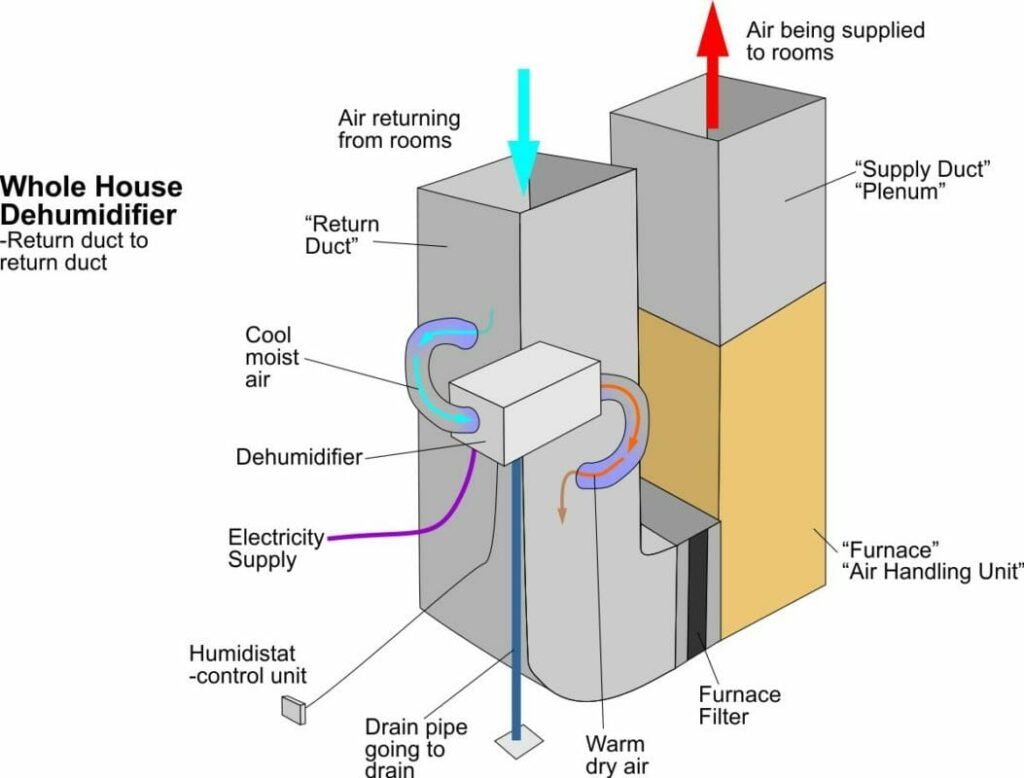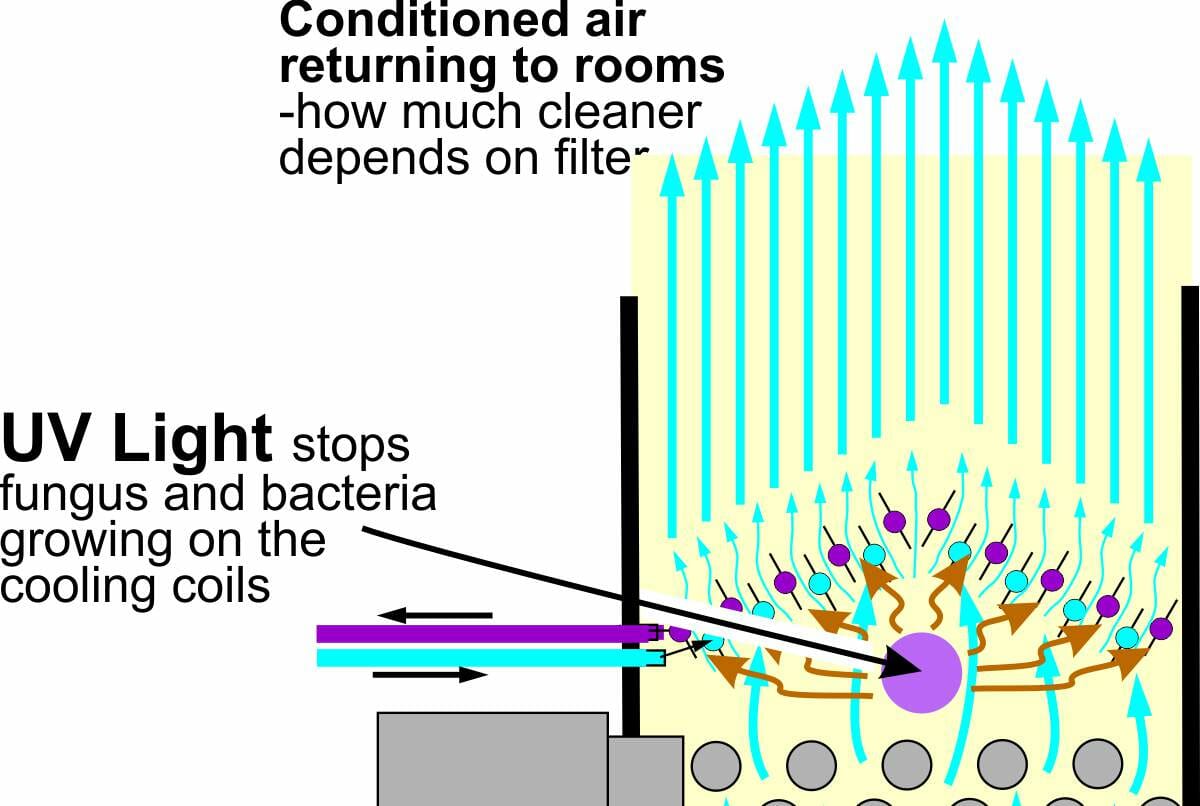All of us want to breathe clean fresh air at home and yet most HVAC systems do not have ultraviolet lights in the air handling unit. So it is worth considering how they work and if there are circumstances in which there are better approaches.
An UV light in an HVAC system is there to destroy micro-organisms and prevent them growing in the air handling unit and ideally in the air going through the HVAC system in general.
As a general rule a UV light in an HVAC system is very effective at preventing fungal (mold) growth on the cooling coils. They are not so effective in killing bacteria, viruses or fungal spores in the flowing air. These are more effectively removed from the air with an upgraded HVAC filter.
One work-based study found that ultraviolet germicidal irradiation (UVGI) of cooling coils and drip pans within an HVAC system reduced microbial growth and endotoxin on the surfaces irradiated by 99%. It also showed a lower instance of work-related symptoms, including respiratory and mucosal symptoms. It was estimated that 4 million Americans would benefit from the installation of UV light in commercial HVAC systems.
In any case you should have a UV light in your HVAC system to stop fungal growth on the cooling coils and improve your indoor air quality. I outline why and how below-
How does UV light work?
UV light damages genetic material, DNA/RNA, as well as some protein coverings of viruses to inactivate microorganisms. It has been used for more than 100 years to sterilize municipal water with sunlight. So HVAC UV lights are often referred to as germicidal irradiation lights. They not only damage microorganisms, but some types of UV light can also damage human DNA.
I have drawn a diagram below showing the energy of the irradiation with wavelength radiation.
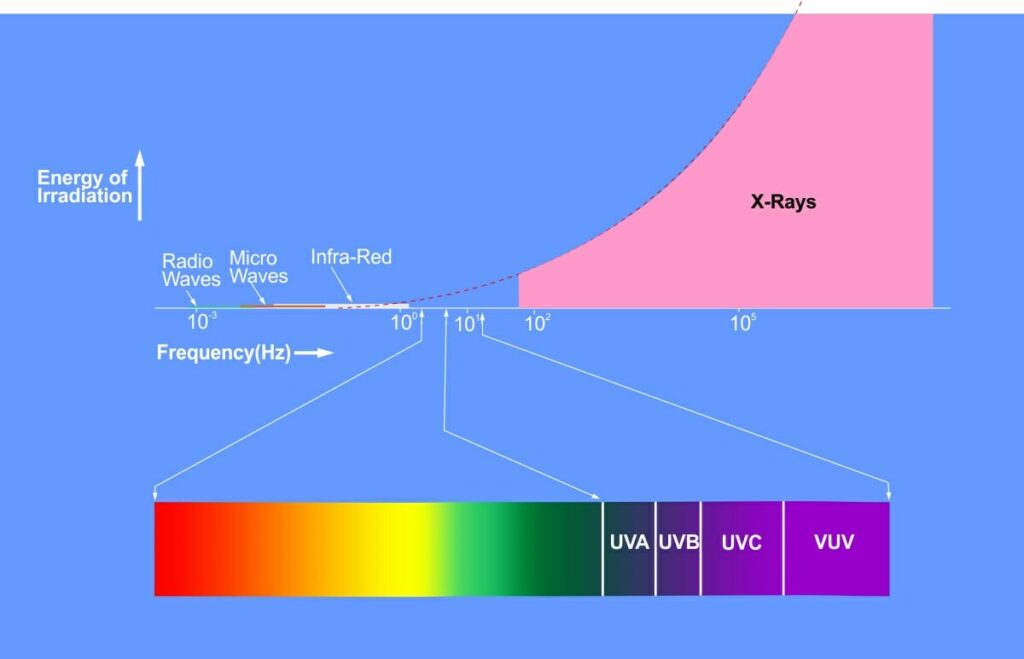
There are 4 types of UV light with increasing energy these are UV-A, UV-B, UV-C and VUV. The energy of the radiation increases exponentially as wavelength decreases and the energy of UVC is in the part of the spectrum where the energy of radiation is starting to take off. UVC has the higher energy compared to that of UVA and UVB, it approaches that of x-rays. It is in the most efficient range of wavelengths for damaging DNA and RNA. Unfortunately it can damage skin and particularly eyes.
If your eyes are exposed to it, you will develop a very painful inflammation of the cornea and sclera-the white part of the eye. It is not in the visible spectrum, so you do not get warning from bright light, and you may not realize that your exposure is significant.
Where do you put UV light in an HVAC system?-Near the cooling coils*
A UV HVAC light is placed near the cooling coils where it can irradiate both the cooling coils and the drain pan. In the following diagram, the configuration of a standard domestic HVAC system is shown. The air comes back from the rooms in the return air duct, then flows through the air filter into the blower (fan) and then travels at about 12 ft./s past the furnace/heating elements and cooling coils. The air then enters the supply ducts to the rooms.

The cooling coils are made of copper with aluminum fins, they appear similar in structure to 2 car radiators at 90° to each other. If you have ever looked at the car radiator, you will know that the gaps between the fins are really quite small and any fungal growth could quite easily impede airflow between the tubes carrying the liquid to be cooled. These coils become moist as water in the air condenses on them. Then particles can stick to the coils including fungal spores which can germinate and the fungus use the water to grow.
The growth of a layer of fungus and bacteria, forming a “biofilm”,on the cooling coils obstructs airflow so less air is delivered to the rooms in the home. In addition, the biofilm insulates the cooling coils so they cool the air less effectively and the air conditioning unit has to use more power to try to achieve the set temperature, which it may fail to achieve. Also, as the blower fan moves air through the cooling coils at some speed, it is possible for fragments of mold and bacteria to break off as well as spores. These can then enter the rooms as airborne pathogens.
The UV lights kill the fungus and any bacteria and stop this happening-“coil sterilization”.
*Other terms for the cooling coils are “evaporating coils” or “indoor coils”.
What does a UV light do for HVAC?-Improve efficiency and air quality
It stops fungi growing on the cooling coils of the air conditioner to give –
- improved air quality-fewer mold spores, fungal fragments, bacteria and bacterial fragments in the air
- improve the energy efficiency of air conditioning by delaying the decline in heat transfer performance of the cooling coils so lowering power consumption by 10-25%-this will more than pay for keeping a 25 watt UVC light on
- improve air flow as fungus does not grow and block airflow through the cooling or “evaporating” coils
- reduce maintenance costs, as the cooling coils do not need cleaning as often
- Reduce odors-the biofilm of fungus/bacteria on the cooling coils produces volatile organic compounds (VOCs) which may cause odors and also contribute to “sick building syndrome”
Do UV lights work in HVAC?-Yes
As a general rule UV lights are very effective at reducing fungal growth on the cooling coils. They are less effective for microorganisms in the air, as the speed at which the microorganism passes the lights leads to a short exposure time and less damage to the genetic material.
1) Microorganisms static on a surface are destroyed eg on cooling coils
Fungi are destroyed by the UVC in an HVAC system because the fungus is growing on the cooling coils and drain pan, so is trapped under the constant glare of the UVC. It is therefore relatively easily destroyed by the UVC as exposure time is long. In one study there was a 98% reduction in fungal spores in the HVAC air handling unit with UV germicidal irradiation lights compared to one without. This was seen when testing the surface of the duct and in the air from the duct following switching the fan on.
Bacteria also settle on the cooling coils and grow contributing to the biofilm on them. They do not add so much to the bulk which is mainly mold ie fungus. UVC light will stop bacteria growing as well
So what about viruses? The first thing to realize is that virus particles cannot grow in an HVAC system like fungi can. Viruses need to enter a living cell and use the cell’s machinery to produce new copies of themselves. Human viruses are not known to be able to do this by invading any fungi on the cooling coils.
However, virus could still stick to the coils and be released later-so do UV lights kill virus? The CDC state that the use of high intensity UV radiation against the virus that causes COVID-19 has not been fully established for surfaces. Surface disinfection is relatively easy because the virus or other microorganisms is trapped on the surface and exposed to the UV light for a relatively long time. Although if it is under a speck of dust on the surface where UV light cannot reach it, it will be protected.
The original SARS-Coronavirus has its outer protein coating destroyed by UVC radiation. One study showed that SARS-CoV-2 needed to be irradiated by a 254nm light for 6 minutes for it to be 99% of virus to be inactivated.
An HVAC system is completely different, the virus flows in the air past the UV light and is in contact with it for a short time.
2) Microorganisms in the air-level of destruction depends mainly on air flow but also light configuration and power
The problem is that the microorganism needs to be irradiated for a considerable period before the DNA/RNA/Protein is damaged enough. So in rooms in hospitals with low airflow UV lights are very effective.
However, the speed of airflow through an HVAC duct determines the effectiveness of this as it limits the time the microorganism is irradiated. If the airflow is very fast the micro-organism is whisked past the UV light and only irradiated for a fraction of a second. At an air stream velocity of 2.2 m/s there is 75% efficiency at destroying mold spores and 87% efficiency in destroying bacteria. However, at an air flow rate of 5.1 m/s there was no detected inactivation of either fungal spores all vegetative bacterial cells. A standard residential supply duct has airflow rate of about 4m/sec (12 ft/sec). So only a few of the bacterial and fungal spores would be likely to be inactivated with this type of system.
More powerful systems to be mounted in the supply duct have been tested and shown to inactivate 99.9% of vegetative bacteria, 72% of virus but only 9% of bacterial spores. The device used 10 times the power of a normal HVAC UV light and the bacteria and viruses were chosen as “reaonable surrogates for biological warfare”. So hardly a usual residential setup although the dimensions of the light could potentially fit residential ducts these type of arrangements are marketed to commerical buildings not residential properties.
To illustrate how difficult the sterilization of flowing air can be, in a large New York building 48 UVC lights each 64 inches long had to be installed in the supply duct to achieve an 88% reduction in bacterial spores.
There is really very little research data available publicly on the effectiveness of UV light for destroying microorganisms in flowing air. This can be seen from the fact that ASHRAE only site for references one from 1941 and one from 1954 and 2 “pilot studies” one of which cannot be reached on the web and the other one is the studies cited in the paragraph above.
So it would be fair to say that UV light can destroy airborne microorganisms, but it is dependent on the speed of the airflow past the UV light and the UV light configuration. In a home HVAC system, an optimal configuration would be very difficult to achieve.
Conversely air is recirculated through the HVAC system many times which gives the system more chances to inactivate the virus or other microorganism.
Similarly in air purifiers the flowing air limits the length of time that microorganisms are exposed to any UV light in the device. I have written an article about this problem here.
So UV lights do significantly reduce airborne fungi in HVAC systems. This is largely because fungus is destroyed if it is static on the cooling coils. So UV germicidal HVAC lights do reduce mold spores and fungal fragments rbeing released into the air.
Do HVAC UV Lights Improve Air Quality?
As a general rule HVAC UV lights improve air quality by reducing fungal spores, fungal particles, bacteria and bacterial particles in the air. However the improvement in air quality is not in the range of particle sizes that is considered most dangerous for human health namely fine and ultrafine particles. Changing your HVAC filter is necessary to reduce these, so you should also upgrade your HVAC filter.
Upgrading your filter is a more effective way of reducing microorganisms in the HVAC air
It is much more likely that the HVAC filter will remove the virus than a UV light system will destroy the virus. A Merv 5 filter has a 30% efficiency a Merv 13 filter 90% efficiency and a Merv 14 filter 97% efficiency at removing virus particles. So by using a high-MERV filter or a HEPA filter you can really improve the particle and hence viral removal efficiency of your HVAC system. I have written an article about this which explains the different types of filter configuration here and how to use your HVAC system as a whole house air purifier here.
Can Germicidal UV light (UVGI) replace air filters in HVAC?-no
As a general rule, UV lights cannot replace filters, UV lights cannot treat inert particles which have been shown to damage human health. The most effective way to deal with particles is to remove them with a filter. However, the usual HVAC filters not very good at removing the size of particles that is responsible for the human health problems. The filter in your HVAC system is unlikely to be MERV16 or HEPA and so you may wish to consider upgrading. I have written an article explaining the problems and options here.
UV Light in HVAC-Where Are UV Lights Positioned?
Cooling Coil Lights
The most common position for UV lights in an HVAC system is just above or below the cooling coils. The light irradiates the coils and very effectively stops fungus (mold) growing on them.
Air Cleaning Lights
Air cleaning UV lights are placed into the supply duct work to treat the air going through the ductwork. As discussed above the effectiveness of this is very dependent on the speed of airflow past the light and the power and configuration of the light. An example of this type of UV system for commercial buildings is seen at this link. This use of UV lights is not general in domestic settings.
Of these two UV light options, coil cleaning lights are the most obvious choice. It is more debatable whether it is worth installing air cleaning lights.
What is the best HVAC UV light for my system?
On average, a good HVAC UV light unit will cost $120. The range is from $40-$650. The cheaper lights are sometimes not UL approved ie do not have electrical certification as safe to be installed. Also, there have been some complaints of UVA lights, which are ineffective in an HVAC system, being advertised as UVC lights.
The Bio-Shield UV-C Air Sanitizer System is an excellent choice. The bulb is by Philips so a respected manufacturer and it is at the lower/mid end of the price range. It uses less electricity than a standard 25w light bulb. It can be brought here.
The Honeywell range are also worth looking at-some of which have carbon filters to remove odors.
What Size UV Light Should I Install in my HVAC System
In general the light should reach from its mounting almost to the other side of the ducting. This ensures adequate irradiation of the cooling coils on the side furthest from where the light is implanted. Ideally the ducting would be aluminum or lined with aluminum as this reflects UV C light much better than other metals such as steel.
The reflection helps to increase the effectiveness not only because more the UV energy is used but the fact that the UV light is hitting the cooling coils from different angles. So the light reaches parts of the cooling coils the light itself could not reach because they would be in the shadow of other parts of the cooling coils for light only coming directly from the UV light.
What Type of HVAC UV Light is Best?
On average, the best type of HVAC UV light is one that emits UVC light and is designed simply to irradiate the cooling coils.
In addition, you could also have one that is designed to sanitize the air but this will consume as much as 20 times as much electricity and filters are more effective at reducing the effect of microorganisms in the air. Filters also deal with inert particles in the air which are human health but which he UV light is powerless to do anything about. The filter also does not consume any electricity but will need changing every year or 2 depending on specification.
Should the UV Light in HVAC be on All the Time?-Yes
To be on the safe side the HVAC UV light should be on all the time. This is ultra safe, and it is quite possible that two 4 hour periods of UV irradiation per day would be enough. I cannot find any research having been done on this. This would allow UV replacement lamps to be brought every 3 years rather than every year as is currently the norm.
For now with information we have it seems best to leave the HVAC UV light on all the time.
How much does it cost to install UV light in HVAC?-About $400
As a general rule it will cost $180 for the light itself and $200 for installation. When installing an HVAC UV light you should have the cooling coils cleaned first-this generally costs $250. If the cooling coils are already covered in mold, then the UV light will not remove the mold and the mold that is growing under the top layer of fungus can keep growing. Also the efficiency of the coils will be affected by the old covering of mold and you will not get the power efficiency savings that you could from your new UV light.
Cleaning the cooling coils is not really an added expense because you should be doing this annually anyway.
You may even want to start with a completely clean slate and in addition have all the ductwork cleaned for $200.
DIY installation is possible but some UV lights can damage human DNA so you need to be careful. Also duct work needs to be carefully sealed and ideally an automatic cutoff installed so that if someone opens the ductwork near the light, the light circuit is broken and the UV light switches off. So you may wish to have an HVAC technician install the light and then you deal with the yearly maintenance.
If you do decide to install one look for a UL listed one UL recognition is not enough. A UL listed one has been tested according to local guidelines, in the US, ANSI/NFPA 70, “National Electrical Code” (NEC). Another thing to watch out for is that UVA (ineffective) lights are sold online instead of UVC lights but this is not made clear in the product description or is even specified as UVC in the description, but when the light arrives, it is marked UVA.
So you need to check that it is UL certified and UVC before installing it.
Here is a video showing how a UV light is installed in an HVAC system-
Some materials break down when exposed to UV C light and so you need to check nothing that will be irradiated by the UV light in your HVAC system is susceptible to this. If there are vulnerable parts for instance plastic they can be covered with aluminum foil which reflects the UV light.
How much maintenance is needed for an UV HVAC system?
As a general rule the UV light in your HVAC system will need changing every year and wiping down every 6 months.
UV germicidal HVAC lights will burn out, a hot cathode tube burns out after about 2000 hours and the more usually used cold cathode tube after 8000 hours or about a year’s use. However, although the power of the lamp decreases, it can be intense enough to prevent fungal growth on the cooling coils for up to 2 years. But after a year the UV light will really be too weak to contribute much to sterilizing the microorganisms in the air, so usually germicidal irradiation lights are replaced annually. A new UV bulb will cost in the region of $50.
The UV lights become covered in dust, which stops some of the light reaching the target. So they also need cleaning to maintain the intensity of the light. Wiping them with a clean cloth every 6 months should be enough. You should avoid touching the lights as the oil from your skin can lead to uneven heating of the glass of the light and reduce its life.
For any HVAC system it is a good idea to every few months look inside the air handler unit and check there is no mold growing there or other problems.
Is UV light in an HVAC system safe?
Having a UV light in your HVAC system is safe, in fact it is safer than not having one as it stops fungal growth on the cooling coils. The thing that makes it safe is that it is in an enclosed metal space which the light cannot penetrate. So you will not be exposed to the light. If you open the cover of the duct where the UV light is irradiating the minute opening the cover should break the light’s circuit and switch the light off.
UVC lights with a wavelength of 222 nm are being developed. They have the advantage of not damaging human DNA but they are much less efficient at killing microorganisms.
Some UV lights are known to produce light at a wavelength of 185nm which is higher in energy and so can produce ozone. Ozone is damaging to the airways of the lungs-
“When inhaled, ozone can damage the lungs. Relatively low amounts can cause chest pain, coughing, shortness of breath and throat irritation. Ozone may also worsen chronic respiratory diseases such as asthma and compromise the ability of the body to fight respiratory infections.” EPA
If manufacturer uses quartz glass with titanium the ozone producing UV wavelengths are absorbed and no ozone is produced. So you should buy your UV light from a respected manufacturer and look for UL certification of zero ozone emissions.
Health Benefits
Fungal particles mold spores when breathed in may act as allergens and worsen respiratory illness such as asthma. Without UV light bacteria can also grow with the fungi on the cooling coils and then be distributed into your indoor air either is endotoxin or whole bacteria. These can then irritate the airways or even cause chest infections.
Conclusion-UV light in HVAC system
So UV technology is useful in HVAC systems for preventing fungal contamination on the cooling coils of the air handling unit. This increases the efficiency of the system and helps prevent mold spores, fungal fragments, bacteria and bacterial fragments from being distributed throughout your home by the HVAC system.
Ultraviolet light also has a direct effect on the air and lead to partial reduction in viral, bacterial, and fungal infectivity.
Related Questions
Sources
Ultraviolet air and surface treatment-ASHRAE
EPA Biological Inactivation Efficiency by HVAC In-Duct Ultraviolet Light Systems
Other Related Posts
Healthier Home? Use your HVAC system as a dream whole home air purifier?
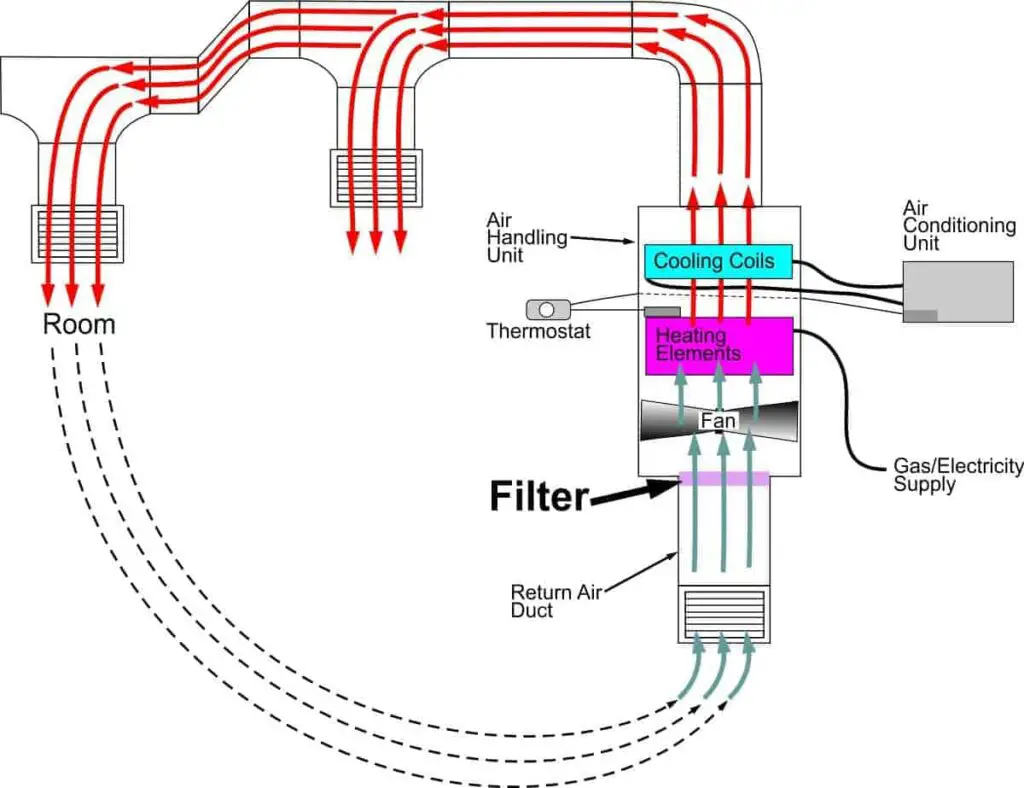
Choose a custom HVAC filter to significantly improve your air quality
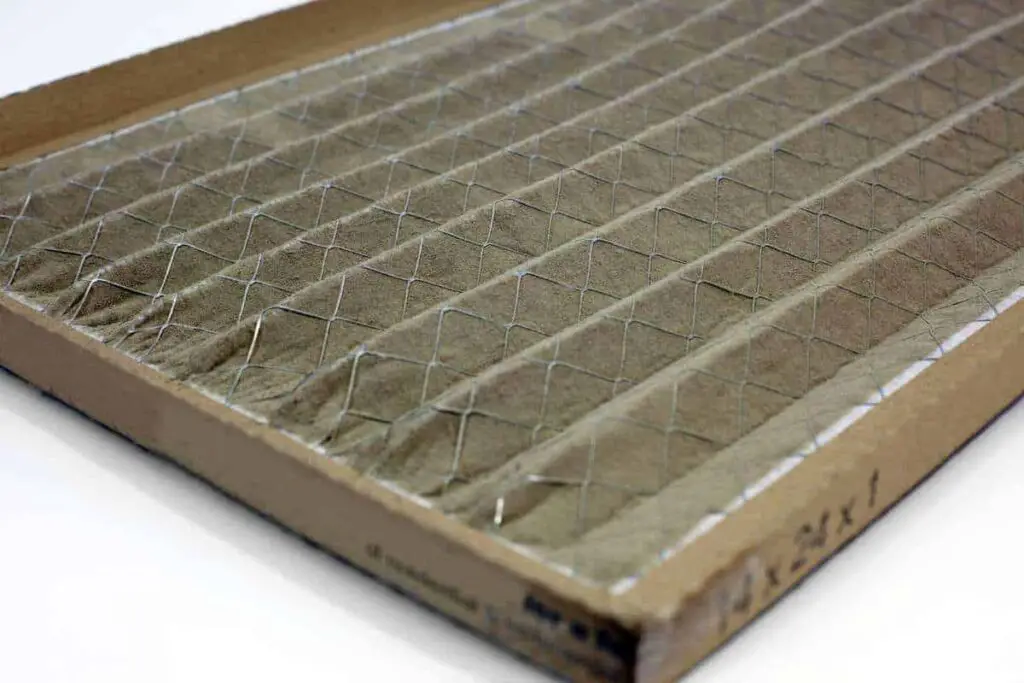
The Best HVAC Filter?-Time to Change Your Filter Technology

Whole House Dehumidifier-9 Important Factors
